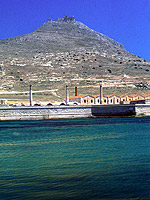
The Mattanza - Favignana
The Mattanza is a very old method of catching tuna. Although because of the passing of time it lost many ancient features, it still has a very old abd fascinating ceremonial.
Since half of April the Tonnaroti (tunas fishermen) begin to let down their nets where shoals of tuna will remain catched between the second half of May and the first half of June when they leave the ocean to go to reproduce in the Mediterranean.
The days of the Mattanza could not be set before. They depend mainly on the route of the tunas and the conditions of the sea because the boats used, the so-called "muciare", are not suitable when there are waves.
You can see the Mattanza directly from the boats of fishermen but usually after a long wait. Tuna’s journey – Following the surface Atlantic current, tuna shoals pass through the Strait of Gibraltar and go towards the northern coast of Sicily. In that period the temperature of the sea of the archipelago of the Egadi is perfect to reproduce: it is around 17 ° -18 °, the salinity is higher than 37 ‰ and a depth of just 20 meters. The current passes near Marettimo and Levanzo but then it detours towards the coast of Trapani. Tuna finds shallow waters between Punta Marsala (Favignana) and the Stagnone Reserve so that they have to go back to Favignana where everything is ready for their arrival. The rais – The rais is the person who runs the whole mattanza. He decides when the mattanza begins and when it ends, when the chambers have to be open or closed and he decides also the position of the boats to facilitate the entry of tunas in the chamber of death. The preparation – The tonnaroti (tuna fishers) get on their boats and tie each one to the other so that one motorboat can haul them offshore. They stop near the St. Peter’s Pole where the rais say the traditional prayer. During it veryone takes off the hat. Then they go to arrange themselves according to the scheme created by the boas and buoys. The chambers – When tunas meet the nets they keep on swimming sideways until they get close to the port where there is another barrier. Since then their fate is settled. These barriers can be very long (up to 4-5 kilometres) and thanks to the morphology of the coast they create a set course for tunas, the so-called "tail" that oblige them to get into the tonnara. Through the vibration of a fishing line thrown overboard because of the passing of tunas, a man can count them and then tell the number to the rais. A series of nets form a sequence of chambers from where tunas can not get out anymore. Normally the chambers are three: "bordonaro", "bastardo" and the "chamber of death". They communicate via mobile nets called "gates". Thanks to an opening-closing system of the chambers tunas are pushed towards the last one, the chamber of death, that is the only one with a net in the seabed as well. While tunas pass from one chamber to another, the previous ones are filled with other tunas that keep on arriving. The chamber of death – When tunas arrive to the death chamber, the ships form a square around them. The biggest boat moves westward following the rais’ orders while fishers start raising the door of the chamber. While they raise the net, the biggest boat completes the square. Everything is done quite fast, gestures are very fast. Everyone knows his role so well as if they have always been repeating the mattanza for centuries. The rais’ "Sciabica" reaches the center of the square. It is tied with ropes to the south and north sides of the square. From there the rais is going to give orders to fishers. In the meantime they raise the corners of the net because they know that then tunas will try to escape from there. These are moments of tension: the solemnity of the rais contrasts with the shouts of incitement of fishers raising the nets. Only after that the "cialomatore" begins to sing and the others join him intoning the Cialoma: old songs that set the pace of the mattanza. However soon the anxiety of tunas for being catched begin to be more visible: they start struggling to survive. Since then there will be no more time to sing because the most brutal part of the mattanza starts. The men are divided into eight groups along the boat’s side, the "stirado", and grab the harpoons. Each group is divided into two rows of four. The four front "arringatori" harpoon the tuna with their "crocchi d'arringare" (harpoons that are 90 centimetres long). Then those behind help them with longer "crocchi" (about 2 meters). And so on until the tuna is in equilibrium on the side of the boat. However the rais gives the green light to the final phase of the mattanza only when the tunas are exhausted, when, because of their very frantic agitation, they have almost killed each other. Slowly some tunas die and the water is tinged with red. Between the streams of blood and the latest flicks of tail, tunas will be all harpooned definitely. Only when the last of these giants is raised the rais will make the signal that the mattanza is over. The net returns to the seabed dragging along the deep red of that slaughter. The return – Slowly the black muciare break the square and form a long queue, almost like a procession, behind the bigger boat that enter the port first. The songs – The Cialome are very old folk songs of Arab origin that set the pace of the movements of the tonnaroti. They on one hand remind of Arab themes, on the other invoke God, the Virgin and the Christian Saints for a very rich fishing. In the past – Tuna fishing in these areas has a very ancient origin. In the Cave of the Genoese (Levanzo – final period of the Palaeolithic) there are two tunas depicted and there were found also vertebras of tuna. During their stay in this area, the Phoenicians enjoyed the particular climate conditions that attract tunas there. The Romans built the first warehouses for the processing and the conservation of tuna. However the songs and a lot of terms used today dates back to the Arabs. The Normans introduced a centralized management of the tonnare. In the 17th century the tonnara was sold: since 1637 it was owned by the Pallavicinis of Genoa then was owned by the Florios and by the Parodis. Since 1985 it is owned by the Castiglione company. For many centuries the mattanza has been representing the main, or rather the only source of income for the whole island and today it attracts hundreds of people each year.
|

